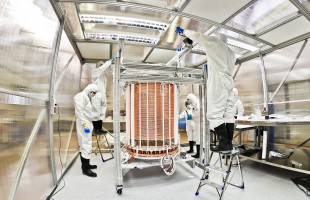XENONnT, a detector built for the search for dark matter, today announced the first measurement of nuclear recoil from solar neutrinos.
The sun makes neutrinos in various nuclear reactions. Neutrinos, like dark matter, hardly react with ordinary matter. Very occasionally they do show up, including by colliding with an atomic nucleus. The recoil of the atomic nucleus is visible and reveals that there was a neutrino.
XENONnT has now seen solar neutrinos collide like billiard balls with atomic nuclei – ‘coherent’ and ‘elastic’ in physics jargon.
Solar neutrinos have not been seen this way before. Previous detectors had to be as much as 10-500 times larger than XENONnT to observe these neutrinos. Those detectors were not sensitive enough to measure the small signals from coherent elastic collisions, but looked at rarer interactions between neutrinos and matter.
Coherent elastic neutrino-nucleus scattering is exactly the kind of signal we hope to see from dark matter. That XENONnT can now measure this signal, albeit for neutrinos, is a nice confirmation that the detector is working well.
About XENONnT and Dutch contribution
Nikhef is one of the partners in the XENON project, which is being carried out deep underground in Italy, shielded from cosmic rays by the granite of the Gran Sasso (Great Rock) above it. At the LNGS laboratory, the Dutch made a major contribution to innovation in recent years, and to the project’s physical measurement programme.
XENON hunts so-called WIMPs, weakly interacting massive particles. These are still unknown particles that could theoretically make up the dark matter in the universe. Dark matter is invisible but would explain about four-fifths of all gravity in the universe. There are no existing particles that could explain it.
See the XENONnT collaboration website (https://xenonexperiment.org/) for more information.
English press release: https://xenonexperiment.org/first-measurement-of-a-nuclear-recoil-signal-from-solar-neutrinos-with-xenonnt/
